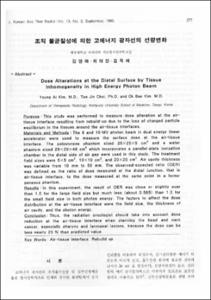KUMEL Repository
1. Journal Papers (연구논문)
1. School of Medicine (의과대학)
Dept. of Medical Biophysics Engineering (의공학과)
조직 불균질성에 의한 고에너지 광자선의 선량변화
- Keimyung Author(s)
- Choi, Tae Jin; Kim, Ok Bae
- Journal Title
- 대한치료방사선과학회지
- Issued Date
- 1995
- Volume
- 13
- Issue
- 3
- Keyword
- Air-tissue interface; Rebuild up
- Abstract
- Purpose : This study was performed to measure dose alteration at the air-tissue interface resulting from rebuild-up due to the loss of charged particle equilibrium in the tissues around the air-tissue interfaces. Materials and Methods : The 6 and 10-MV photon beam in dual energy linear accelerator were used to measure the surface dose at the air-tissue interface. The polystyrene phantom sized 25X25X5cm³ and a water pahntom sized 29X29X48cm³ which incorporates a parallel-plate ionization chamber in the distal side of air gap were used in this study. The treatment field sizes were 5X5cm², 10X10cm², and 20X20cm². Air cavity thichness was variable from 10mm to 50mm. The observed-expected ratio (OER) was defined as the ratio of dose measured at the distal junction, that is air-tissue interface, to the dose measured at the same point in a homogeneous phantom. Results : In this experiment, the result of OER was close or slightly over than 1.0 for the large field size but much less (about 0.565) than 1.0 for the small field size in both photon energy. The factors to affect the dose distribution at the air-tissue interface were the field size, the thickness of air cavity, and the photon energy. Conclusion : Thus, the radiation oncologist should take into account dose reduction at the air-tissue interface when planning the head and neck cancer, especially parynx and laryngeal lesions, because the dose can be less nearly 29% than predictied value.
목적 : 임상 방사선치료에서 병소선량은 인체 연부조직의 방사선흡수와 유사한 수조펨텀에서 측정환산된 흡수선량자료를 이용하여 얻어지고 있으며, 방사선 치료부위내 공기층 또는 밀도가 낮은 폐조직 주위에 종양이 존재할 경우 공기층과 만나는 종양의 경계면 선량은 rebulid-up에 의해 낮아질 수 있으나 현재까지 연구 발표된 것은 많지 않다. 이에 본 연구에서는 6, 10메가 볼트 광자선을 이용하여 조직 불균질층 경계면 선량을 실험적으로 측정하여 종양선량에 미치는 영향을 분석하여 방사선 치료선량 결정에 이용하고 하였다. 방법 : 고에너지 광자선의 조사면내 조직 불균질성에 의한 선량변화를 얻기 위하여 조직층에 해당되는 폴리스티렌 고체팬텀의 두께가 각각 10, 30, 50mm인 경우 공기층의 두께를 10, 20, 30, 50mm로 변화시켜서, 이러한 조직층과 공기층을 지나 종양의 가장자리에 해당되는 수조펜텀의 표면에 도달되는 방사선량을 평행평판형전리함으로 측정하였다. 방사선 조사면적은 암상에서 비교적 많이 이용되는 5X5, 10X10, 20X20cm²를 사용하였다. 결과 : 방사선 조사면적 5X5cm²이고 조직층 두께 30mm일때 6 메가볼트 광자선에서 공기층 두께변화에 따른 표면선량 변화는 표준선량보다 공기층 10mm에서는 1.1%, 50mm에서는 29.1% 낮아졌으며 공기층 두께가 두꺼워질수록 방사선량 감소가 현저했다. 같은 조건에서 10메가볼트 광자선에서 선량변화는 표준선량보다 4.2%에서 33.9%까지 낮아졌다. 동일 깊이에서 표준심부선량에 대한 불균질 조직층 선량의 비인 OER은 조사면적 10X10cm²이상에서는 1ㅂ조다 크거나 1에 가까운 값을 보였다. 결론 : 방사선 조사면적이 커지면 공기층과 인접한 조직 경계면의 선량감소는 거의 나타나지 않으며 10X!0cm²이하의 소조사면 치료시 조직 경계면의 종양에 대한 치료선량 평가에는 rebuild-up 효과를 고려하여야 될 것으로 생각된다. 임상에서 6 메가볼트 광자선을 사용하여 공기층이 존재하는 구강과 인후두 종양을 치료할 때, 공기층에 인접한 점막층 (1-3mm)의 선량은 표준선량에 비해 29%까지 적게 도달될 수 있으므로 방사선 치료선량 결정에 이러한 결과를 필히 고려하여야 될 것으로 사료된다.
- Alternative Title
- Dose Alterations at the Distal Surface by Tissue Inhomogeneity in High Energy Photon Beam
- Publisher
- School of Medicine
- Citation
- 김영애 et al. (1995). 조직 불균질성에 의한 고에너지 광자선의 선량변화. 대한치료방사선과학회지, 13(3), 277–283.
- Type
- Article
- ISSN
- 1225-6765
- 파일 목록
-
-
Download
 oak-bbb-3843.pdf
기타 데이터 / 1.09 MB / Adobe PDF
oak-bbb-3843.pdf
기타 데이터 / 1.09 MB / Adobe PDF
-
Items in Repository are protected by copyright, with all rights reserved, unless otherwise indicated.